Planning to spend 3 days in Lisbon and need some itinerary inspiration? You’ve come to the right place – read on for all the best things to do, see, and eat!
There are so many amazing cities in Europe that it is pretty much impossible to pick just one as a favorite – but after spending 3 days in Lisbon, the city quickly rose to one of the top on my list (I’m not saying the very top, since I still can’t choose just ONE city). With its pretty azulejos-tiled facades, hilltop views, hip vibe, and the amazing egg tarts (ESPECIALLY the egg tarts), how could it not?
Admittedly, Lisbon was never on my radar until the last few years, when photos of it started popping up all over Instagram. I immediately became intrigued when I saw the colorful tiles, the iconic yellow trams, and those red-roofed views – it looked like one of the most photogenic cities, ever.
So when I found myself a $400 round-trip flight from San Francisco (aka home), I immediately jumped on it and was sooooo excited to finally go to Lisbon! And like I said earlier – the city definitely lived up to all my expectations and then some! I became absolutely, head-over-heels in love with this city.
Follow along on this itinerary to discover all the best things to do, see, and eat in Lisbon in 3 days so you, too, can fall in love with this city!
Disclosure: This post contains affiliate links. This means that if you make a purchase or booking, I may receive a small commission at no additional cost to you. Pictures & Words is a participant in the Amazon Services LLC Associates Program, an affiliate advertising program designed to provide a means for us to earn fees by linking to amazon.com and affiliated sites at no cost to you.


When to Go to Lisbon
Lisbon has a Mediterranean climate, which means that the weather is relatively mild year-round, making any time a good time to spend 3 days in Lisbon.
Like much of Europe, Lisbon’s high season is during the summer months, between June and August. This is when the city is at its most crowded, and when flights and accommodation prices tend to be at their highest. Booking accommodations, as well as tickets to the city’s most popular attractions, well in advance is absolutely essential.
On the flip side, Lisbon is a wonderful summer destination, with the city coming alive with numerous festivals and outdoor events. Do note that the city can get relatively hot, with temperatures reaching up to 95 degrees Fahrenheit/35 degrees Celsius on the warmest days. These hot days are an excellent time to spend outdoors by the river, or to visit the nearby beaches. It would also be the perfect time to add Lisbon to a Portugal itinerary that also visits the towns in the Algarve.
An even better time to visit is during shoulder season, usually March-May or September-October. The weather is still pleasant during this time, with average temperatures ranging from 68-77 degrees Fahrenheit/20-25 degrees Celsius, which means that you can still enjoy being outside.
A bonus is that the crowds are much thinner during this time, and you can enjoy the city without dealing with swarms of people everywhere you go. This also means that accommodations are much more affordable, so you can score some great deals on some of the city’s best hotels!
I visited Lisbon at the end of November, and still found it an excellent time to go. While average temperatures in the winter can be as low as 54 degrees Fahrenheit/12 degrees Celsius, the city’s proximity to the Atlantic Ocean means that the weather is much milder than in other parts of Europe, making it an excellent winter destination – perfect for this California girl who can’t handle the cold!
While it did rain a few times during my 3 days in Lisbon, the temperatures hovered around the low-mid 60s Fahrenheit (~15 degrees Celsius), which I thought was quite pleasant! I wasn’t quite sure what kind of weather I would actually get since the forecast kept changing before I left, so I packed lots of sweaters, and found myself being a bit too warm. I would absolutely suggest packing layers instead so you can be prepared!
How to Get to Lisbon
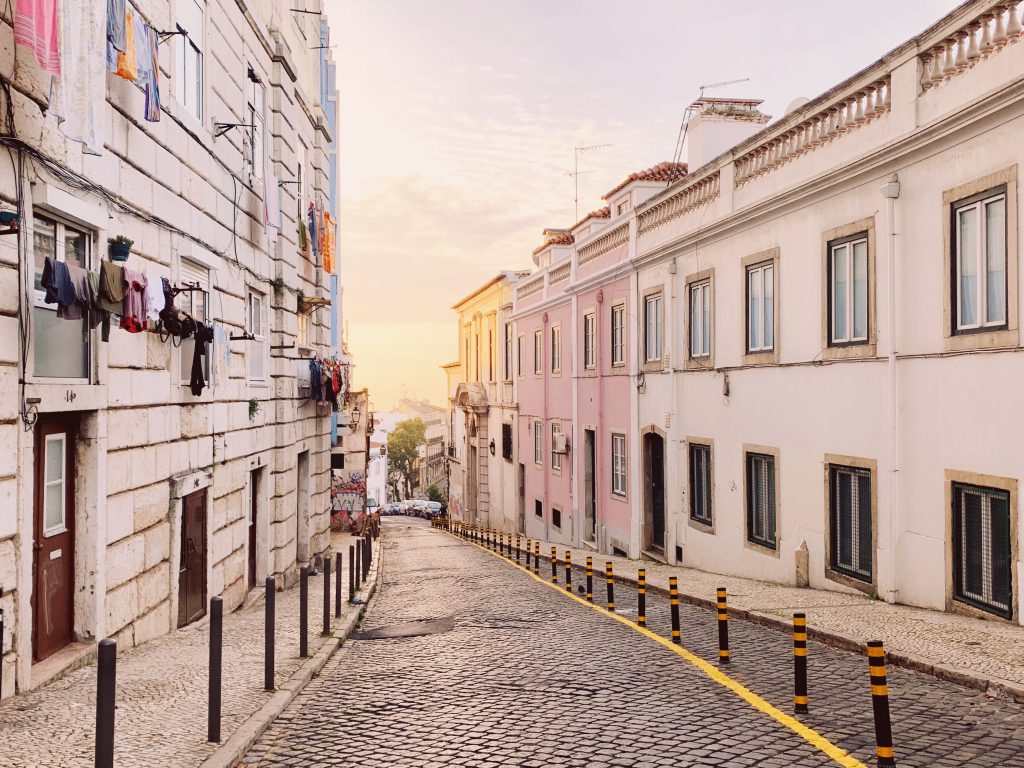
By air
I flew into the Lisbon Portela Airport (LIS), which is Portugal’s busiest airport with connections to many domestic, European, and international destinations. The airport is only 6.5 kilometers (~4 miles) outside of Lisbon’s city center, and there are several options for getting there:
- Taxi: This costs around €35. pay your taxi fare at the taxi stand at the airport to avoid any misunderstandings about pricing.
- Uber/Bolt: Another convenient option is to take Uber or Bolt (another app similar to Uber, which is also slightly cheaper) which will run you about €10-15 depending on distance, traffic, and demand. The pickup point is located outside the departures area in Terminal 1, at the “kiss & fly” parking area. (The pickup point can always change, so be sure to pay attention to what your app tells you so you get picked up in the correct spot).
- Private Transfer: If you are traveling to Lisbon in a small group (up to 3 people), hiring a private transfer is a hassle-free way to get from the airport to your accommodations. Your driver will greet you in arrivals at the airport, and will drop you off directly to your hotel.
- Metro: The most inexpensive way to get into the city is to take the metro. The Aeroporto – Saldanha line (or the Red Line) offers service into city center, however, you may need to transfer trains depending on where your destination is. The station is near Terminal 1 – you can also take a shuttle from Terminal 2. The journey takes about 20 minutes, and costs €1.65. You must also purchase and load your fare onto a Viva Viagem transit card, which can reload your transit fares.
By rail
You can also arrive via train. The Santa Apolonia station connects the city via rail to cities in northern and eastern Portugal, as well as other major European cities, such as Madrid and Paris. Santa Apolonia is located right next to the Alfama district, just outside the city’s historic center. You can easily hop on the metro’s blue line to connect to other points in central Lisbon.
Lisbon’s other major train station is Oriente, which sits about 7 km northeast of the city center. Oriente primarily connects Lisbon to other major destinations in Portugal, such as Porto, Evora, and the Algarve. From Oriente, you can connect to the metro red line to get into central Lisbon, or take a quick and fairly inexpensive taxi or Uber ride.
There are also two smaller stations that serve suburban train routes – Rossio, which connects Lisbon to Sintra; and Cadro Sodre, from which serves the Cascais route.
How to Get Around When Seeing Lisbon in 3 Days

Walking
Lisbon is a very walkable city, and one of my favorite things to do was strolling through and getting lost in all of the city’s the charming streets and alleys. That said, Lisbon is very hilly (it reminded me a lot of San Francisco, aka home for me) and has a ton of uneven cobblestone streets – this means that good shoes are an absolute must!
Public Transportation in Lisbon
Many of the city’s main attractions that are included on this 3 day Lisbon itinerary are easily reached on foot. However, if you get tired of walking, or for those points of interest that sit outside of the city center (i.e. in Belem), Lisbon has a fairly well-connected and public transportation system, making getting around a breeze.
Lisbon’s public transportation is operated by three companies – Carris, which operates the city’s buses, trams, and funiculars; the Lisbon Metro; and CP (Comboios de Portugal), the national Portuguese rail company which operates suburban trains to destinations such as Sintra and Cascais.
I recommend that you get a reloadable Viva Viagem transit card to pay for transit, as this will save you some money (€1.47 on the card vs. €1.65 to buy a regular fare). The card costs €0.50 and can be purchased at any metro station kiosk. You can pay for single ride fares on board buses and trams, or at a ticket machine in the metro stations, but this will be more expensive.
You then have a few options on how to pay for transit, based on your needs:
- Pay-as-you-go: You can add credit to your Via Viagem card in €5 denominations for to pay for transit fares as you go. Single-ride fares when zapping are €1.47 on the entire network.
- Metro/Carris Day Pass: This costs €6.60 and allows unlimited use of the metro, and Carris buses, trams, and funiculars during any 24 hour period. If you are planning to use public transport at least 4 times in any given day, this is your best option.
- Metro/Carris/CP Day Pass: This pass costs €10.70 and is a good option if you are planning to take a day trip to Sintra or Cascais, as well as use public transportation within Lisbon.
- Lisbon Card: This 24, 48, or 72 hour city pass includes a transit pass, as well as admission into several of Lisbon’s most popular attractions. I ended up skipping this option, as I was not planning to go to many of the places that the card covered and it was not worth it for me.
Ride Shares and Taxis in Lisbon
Uber also operates in Lisbon and is another convenient way to get around the city. Cars are usually readily available, and fares are relatively inexpensive.
You can also take taxis around Lisbon, but they are more expensive than ride sharing. I much prefer using ride sharing while traveling, because you use the app to tell the driver exactly where to go, and to calculate fares. This will prevent any miscommunication due to language barriers, and will help you avoid getting ripped off.
Hop-on Hop-off Tour
Jumping on one of these tours can be an easy, albeit touristy, way to get around, especially if you are trying to see Lisbon in 3 days. In Lisbon, there is not only a hop-on, hop-off bus tour, but also a tram tour, and a boat tour that cruises down the Tagus river!
The best part about these hop-on, hop-off tours is that it will take you to most points of interest itinerary, without having to worry about getting lost. You can also listen to the audio commentary to find out more about the city and the places you’re visiting!
You can see where the tours stop, and book here – this specific tour is a great value because it also includes a Lisbon transit pass, and the Aerobus airport shuttle!
If you are considering a day trip to Sintra, you might also consider this one, which is only a bus tour, but also includes access to the hop-on, hop-off tours in Sintra (and Cascais).
Other Travel Tips for Seeing Lisbon in 3 Days


Language in Lisbon
While Portuguese is the official language in Lisbon, almost everyone speaks English, especially in the main tourist areas. Regardless, I do try to make an effort to learn a few basic phrases in the local language when I travel, and some helpful Portuguese phrases are below:
- Olá: hello
- Adeus: goodbye
- Obrigado: thank you
- Sim: Yes
- Não: No
- Bom dia: Good morning
- Boa tarde: Good afternoon
- Boa noite: Good evening
Money and Currency in Lisbon
Lisbon, along with all of Portugal, uses the Euro. Before I left , I kept reading that many establishments did not accept international credit cards (or only accepted credit cards with a PIN, which are not common in the United States), which had me a bit worried. However, I did not find that to be the case once I arrived and ended up using mostly credit cards during my 3 days in Lisbon.
It is still a good idea to carry some cash on hand, as some smaller shops and restaurants do not accept cards. It is best to get cash out of a bank ATM rather than a currency exchange booth, as the rates are much more favorable. I usually withdraw cash as soon as I arrive in a country – I got some at an ATM at the Portela airport – but you can easily find ATMs and banks all around the city.
Tipping isn’t mandatory, although it is sometimes expected in tourist-centric establishments, or upscale restaurants. A tip of 5-10% is standard for good service, or you can round up the bill (for example leaving €40 on a €37 bill). Check your bill before you add a tip, as gratuity is sometimes already added. Tipping is not expected at cheaper, more casual establishments.


Safety in Lisbon
Lisbon has a reputation for being one of the safest European capitals, with a very low crime rate and very few instances of violent crime. I visited the city as a solo female traveler, and felt very safe.
That said, you should always exercise common sense and take basic precautions: don’t walk around alone late at night (especially outside of the main streets), don’t go anywhere with strangers, don’t get too intoxicated, and always watch your surroundings!
While violent crime is extremely rare in Lisbon, pickpocketing and petty theft are unfortunately a major concern, as in many other large European cities. Pickpocketing is most common on public transportation (especially on the famous #28 tram), in outdoor restaurants and cafes, and in crowded city squares (i.e. Praca do Comercio).
Always, always, ALWAYS keep an eye on your belongings, leave your valuables behind in your hotel safe, and never, ever leave anything out unattended! Make sure that your bags are zipped, and don’t leave stuff in your back pocket. If you are sitting down at a restaurant or cafe, hold on to your bag, and don’t leave things, like your phone, out on the table.
I always like to keep my important belongings in a crossbody that stays on my person at all times, and I always keep an extra hand on it, especially if I’m walking through crowded areas or on public transportation. For extra security, carrying an anti-theft bag (like this crossbody, tote, or backpack), or a money belt may be a good idea.
Another thing to watch out for is people trying to sell you fake drugs. This is especially common on Rua Augusta and in Bairro Alto at night. Some of them can be a bit aggressive, but learning to say NO firmly and walking away will get them to back off quickly.


What to Pack for Lisbon:
- Power adapter: As with the rest of Europe, Portugal 230 V Type E power plugs. If you are coming from the United States, you will need an adapter. This is the adapter that I bring on all of my international travels.
- Power bank: Keep your devices charged – for using maps to navigate your way through those narrow little streets, or to snap a bunch of photos of those charming tiled buildings! I never leave home without this handy power bank, which is my favorite because it charges my devices fast, and has lots of juice (one charge of the power bank will last you about 5 full charges of your devices).
- Good shoes: Lisbon is full of cobblestone streets and giant hills. You will want a pair of sturdy, comfortable shoes – this is not a city where you will want to sport your flimsy sandals or heels! My favorite travel sneakers are from Allbirds, and my favorite travel flats are from Rothy’s. For warmer months, I also love these sandals from Crocs – which are super comfy and stylish, I swear!
- Reusable water bottle: You’ll want to make sure to stay hydrated as you walk around the city – those hills are no joke! Another thing to keep in mind is that in Europe, there is usually no free tap water at restaurants, and will have to pay for bottled water. In Lisbon, beer and wine are so cheap that the water costs almost as much, or even more than the booze! Carry your own water with you to avoid having to avoid paying for water when you eat out, and spend that money on a tasty glass of beer or wine instead!
Is 3 Days in Lisbon enough?
I thought spending 3 days in Lisbon was the perfect amount of time to get a good introduction to the city. You can definitely see all of the city’s highlights when you do Lisbon in 3 days. However, I ended up loving Lisbon so much that I definitely wished I had more time in the city – definitely want to come back sometime soon!
Where to Stay During Your Lisbon 3 Day Itinerary
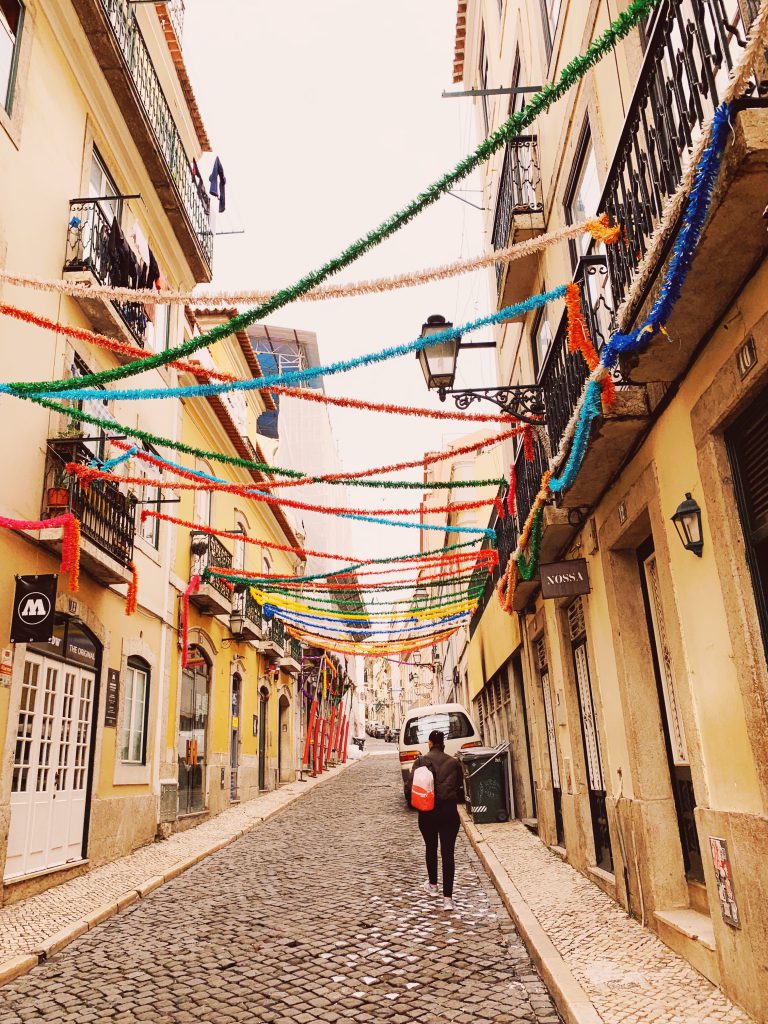

Lisbon boasts a wide variety of accommodation options, suiting a range of tastes and budgets. For the most convenience and to make the most of seeing Lisbon in 3 days, I’d recommend staying in one of the neighborhoods that are clustered near the historical center; however, there are a ton of lovely (and affordable) places to stay in Belem as well.
Generally speaking, I found the hotel prices in Lisbon to be relatively affordable, especially compared to similar European capitals.
Here are some of the best neighborhoods to stay in during your 3 days in Lisbon:
- Baixa, Rossio, and Chiado: Staying in one of these neighborhoods will put you right in the middle of the city center, with easy access to almost anywhere you need to go.
- Alfama: The oldest neighborhood in Lisbon, and full of historical charm and romance.
- Bairo Alto: Best for those party animals – this is known as the nightlife district. Best to avoid if you are looking for a peaceful neighborhood.
- Cais do Sodre: This district is just outside of the historical center, and is now the up-and-coming neighborhood.
- Belem: A bit far from the center of the city, but you will be near some of the city’s top UNESCO-listed historical sights. You’ll get the best bang for the buck here, as the hotels here tend to be more inexpensive than in the city center.
Here some picks for where to stay, listed by budget:


Best Hostels in Lisbon
- Sunset Destination Hostel: This hostel has earned a reputation as one of the top hostels in Lisbon, and has its very own pool, chillout dome and bar, which overlooks the Tagus. There’s even an urban garden where you can pick your own sunflowers, as well as pool parties, and Portuguese BBQ parties. They also offer a variety of super fun activities, such as pub crawls, street art tours, and a food tours “for the brave.”
- Home Lisbon Hostel: This hostel has won the HOSCAR award for bring the best medium-sized hostel WORLDWIDE and is truly designed to be your home away from home. The corridors are lined with the owner’s family photos, and they even host “mama’s dinners,” cooked by the owner’s mother!
Best Budget Hotels in Lisbon
- GS Chiado Boutique Studios and Suites: Located between Baixa and Chiado, you can’t beat the location here. The property has a rustic feel, and many of the rooms offer a private balcony that overlooks the Sao Jorge castle.
- Palacio Vila Flor: This charming guest house puts you right into the middle of the historical neighborhood of Alfama. There are lots of vintage touches here, along with a beautiful courtyard and terrace that is decorated with colorful azulejos.
Best Mid-Range Hotels in Lisbon:
- Lisboa Carmo Hotel: You can’t beat the views at this 4-star boutique hotel – they look out onto the Tagus River and the Sao Jorge castle. The rooms are stylishly decorated in pastel colors, and come with amenities such as free bottle water and coffee.
- MyStory Ouro Hotel: This property is conveniently located in the heart of the Baixa district, and is beautifully decorated with iconic azulejos tiles. This boutique hotel combines historical charm with modern design, and has a sophisticated yet relaxed atmosphere.
- Browns Central Hotel: This centrally located hotel has a “modern chic and easy attitude” vibe. The trendy, artsy hotel is centrally located in the middle of the Baixa district and provides breakfast and a welcome drink.
- Hotel Gat Rossio: Where I stayed – you can’t beat the value and location here! This modern, stylish hotel has a boutique-y hotel but at a super affordable price point. There’s free breakfast, lots of communal spaces (including a beautiful terrace area), and super comfortable rooms. It is also located right next to the Rossio train station, putting you right in the middle of all the action. You can read more about my stay at Hotel Gat Rossio here.
Best Luxury Hotels in Lisbon
- Pestana Palace Lisboa Hotel & National Monument: This luxury boutique hotel is built inside a former palace and family home that has been classified as a national monument since 1997. This opulent hotel has been named one of the Leading Hotels in the World, recognized for its world-class service. The attention to detail here is insane, with extravagant furniture, romantic frescoes, and an exotic garden, in which you can enjoy a picnic on Sundays.
- Verride Palacio Santa Catarina: Another luxury hotel that is housed in a restored palace, this elegant hotel is inspired by the best of what Portugal has to offer and features a rooftop deck and pool with unparalleled views of the city. The property has an elegant yet cozy vibe, and is known for its attentive, personalized service.
The Ultimate 3 Days in Lisbon Itinerary

3 Days in Lisbon Itinerary: Day 1 (Bairro Alto, Cais do Sodre, Belem)
Calcada da Gloria
After starting the day off with some coffee and pastel de natas, I stumbled upon this funky street. The Calcada da Gloria is the street where the Elevador da Gloria funicular line operates, and is full of colorful murals and graffiti. The combination of street art and the iconic tram cars of the funicular makes for some super cool photo ops!
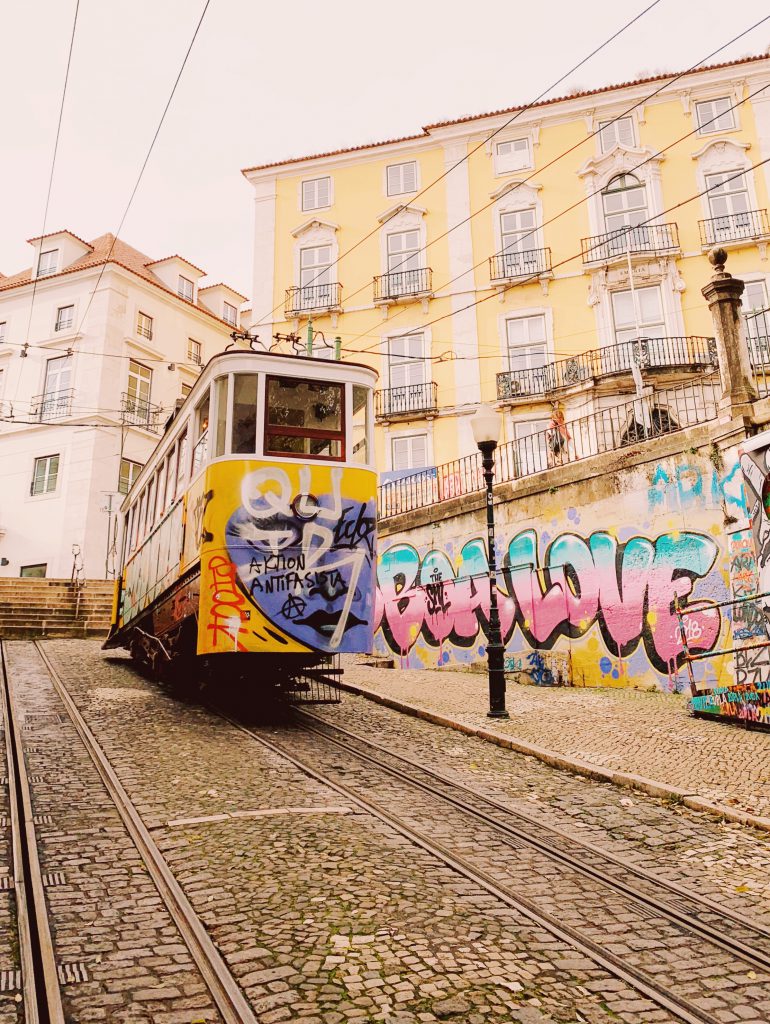

One of my favorite things during my 3 days in Lisbon was seeing all the cool street art scattered all around the city – this street is one of the best spots to experience it! The Calcada da Gloria is essentially a street art gallery that is promoted by the city council, which created a street art project called GAU (Galeria de Arte Urbana), which started here on this street and spread throughout the city.
If you’re interested in checking out more of the street art in the city, you can check out this walking tour.

Miradouro Sao Pedro de Alcantara
The Calcada da Gloria and Elevador da Gloria line terminate at the Miradouro Sao Pedro de Alcantra. Lisbon’s many hills mean that there are many miradouros, or viewpoints, scattered throughout the city. The best part about these miradouros is that they are all FREE so there is no need to ever pay for a great view of the city on your 3 day Lisbon itinerary!
Both locals and tourists gather at these miradouros to enjoy the view. If you come to a miradouro around sunset or on the weekends, you’ll often find people hanging out with a picnic, throwing back some drinks, and playing music – it’s a super fun and lively atmosphere!
The Miradouro Sao Pedro de Alcantara sits at the edge of the Bairro Alto district and sits on two beautiful terraces and a landscaped garden. From here, you get an expansive view of the city center, and of the Sao Jorge castle far off in the distance.
While I stopped by in the morning, I’ve heard that this miradouro in particular especially comes alive around sundown, so it might be worth coming back to in the evening!


Bairro Alto
Afterwards, you will eventually make your way towards the Time Out Market in Cais do Sodre for lunch, which gives you the perfect opportunity to walk through the streets of Bairro Alto!
Bairro Alto is most famous for its nightlife – it has one of the highest concentrations of bars in Europe – but the historic neighborhood dates back to the 16th century, and was once the city’s bohemian hub for artists and writers.
It is full of narrow, windy (and mostly hilly) cobblestone streets, charming tiled facades, and funky street art, making it a fun neighborhood to stroll through. It has a completely different feel during the day, when it is peaceful and quiet. At night, the area comes alive with its vibrant nightlife, with people spilling out of its many bars and restaurants into the late hours.
It’s definitely worth coming back at night, not only to experience the nightlife, but because it’s so interesting to see the contrast between day vs. night in this neighborhood!

Elevador da Bica (Rua da Bica de Duarte Belo)
This is another great spot to photograph those iconic trams. This tram climbs up one of the steepest hills on Rua da Bica de Duarte, between Belo Rua de São Paulo and Largo do Calhariz.
This funicular route is considered to be one of the most scenic in Lisbon – the river and the yellow tram cars are perfectly framed by the pretty pastel buildings on either side. It’s definitely a postcard view!
From here, you can continue up the hill to check out the view from the nearby Miradouro de Santa Catarina, or head back down towards Cais do Sodre to continue along on this Lisbon 3 day itinerary.

Rua Nova do Carvalho (aka “the pink street”)
At some point, you probably have seen a photo of this infamous pink street, located on Rua Nova do Carvalho in the Cais do Sodre neighborhood. While you may think that the street was painted in its vibrant pink shade specifically for Instagram, that is not the case at all.
Cais do Sodre once had a reputation for being one of the seediest neighborhoods in Lisbon. The now Instagram-famous street used to be the home of Lisbon’s Red Light District, once serving as a meeting point for sailors, local criminals, and prostitutes.
Over the years, the neighborhood has gentrified and it has shed its seedy reputation. Hip bars and restaurants have opened to replace the brothels and gambling dens of the past. As part of the revitalization project, the street was painted its current pink color in 2011.
The street is known for its nightlife, and comes alive after dark. In the daytime, it is pretty empty and quiet. While I usually recommend coming to Instagram-famous spots as early as you can in the day in order to avoid crowds, this isn’t the case here – if you come early, there will still be trash on the street! Instead, I suggest coming to snap your photos here around lunchtime.
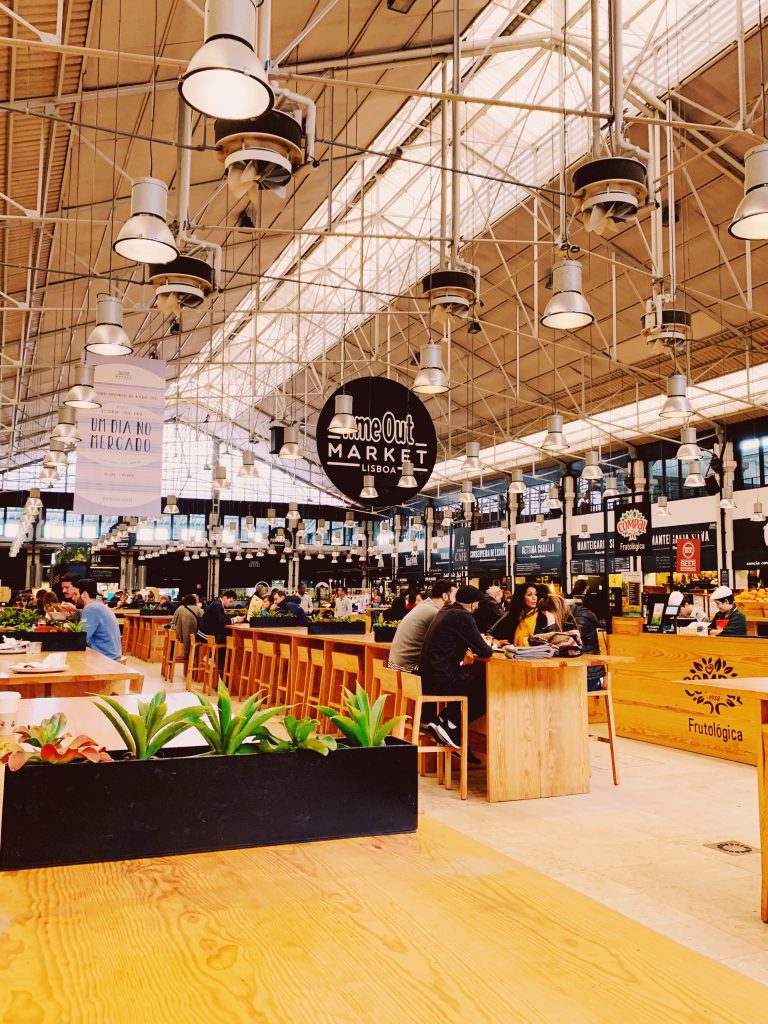

Time Out Market
And speaking of lunchtime, you must be hungry! Stop for lunch at the Time Out Market, where you can sample all the best of Lisbon’s food and drinks in one place. The indoor market, which is also known as the Mercado do Ribiera, features a collection of 26 restaurants, eight restaurants, and a dozen shops, all hand-selected by the editors of Time Out Magazine to be the best of the best in the city.
I honestly could have come back here again and again because there was soooo much good food to be eaten here, but alas, I only had time for this one visit. You can find almost any kind of food here, so chances are that whatever you’re craving, you’ll probably find it here!
Time Out Market does get crowded AF, especially after noon. I suggest getting an early start on day 1 so that you can eat an early lunch here and beat all the crowds!
Address: Av. 24 de Julho 49, 1200-479 Lisboa
Hours: Sunday-Thursday 10am-midnight, Friday-Saturday 10am-2am
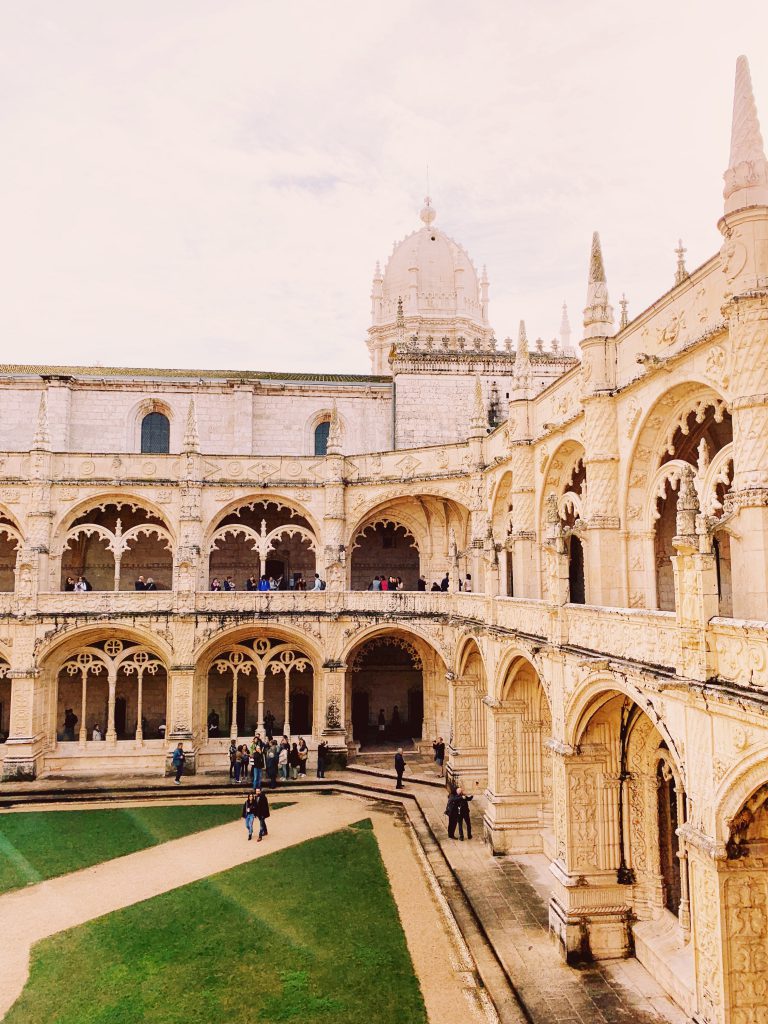
Belem
After lunch, make your way to the historic neighborhood of Belem, which sits about 7 kilometers (~4.5 miles) west of central Lisbon. It is from here that the famous Portuguese explorers set off on their expeditions around the world. Because of this, there are many historical landmarks, monuments, and museums to explore in the area.
The fastest way to get to Belem from Cais do Sodre is to take the suburban CP train headed towards Cascais. The Belem station is only 3 stops away from Cais do Sodre, and the trip only takes 9 minutes. However, it is more expensive than just taking a tram or bus. I also ended up getting super confused and ended up buying the wrong transit day pass – oops.
The simplest and cheapest way to get to Belem is to take the 15E tram. The trip takes about 30 minutes; get off at the Mosteiro dos Jeronimos or Largo da Princesa. While the train is faster, the tram runs more frequently, so it may take about the same amount of time anyway.
After you arrive, walk towards the water to the Monument to the Discoveries.


Monument to the Discoveries (Padrao dos Descobrimentos)
Built in 1960, the Padrao dos Descobrimentos commemorates 500 years of Portuguese discoveries. The enormous monument towers 52 meters (170 feet) high, and is shaped like a three-sail ship ready to depart, with sculptures of 32 of the most famous Portuguese explorers at their helm.
Initially, I wasn’t all that interested in seeing the Monument to the Discoveries, but figured I may as well stop by since it was right next to the Belem Tower. I ended up being pretty impressed at the sheer size and the amount of detail of the monument – it is definitely worth checking out!
From here, you can also enjoy a beautiful view of the river and the 25 de Abril Bridge, with the Sanctuary of Christ the King monument off in the distance.
If you want to learn more about Portuguese exploration, there are exhibitions inside the monument. From here, you can also take an elevator to the top for a bird’s-eye view of Belem.
Hours: Tuesday-Sunday 10am-6pm, closed Mondays
Admission: €5


Belem Tower (Torre de Belem)
Perhaps one of Lisbon’s most iconic structures, the Torre de Belem was originally built as a fortress to guard Lisbon’s harbor and to serve as a ceremonial gate. It was also a monument to Portugal’s power at the time served as the starting point for many Portuguese voyages.
This UNESCO World Heritage Site is a prime example of 16th century Manueline (Portuguese late style Gothic) architecture. The tower has some unique architectural details, with lots of balconies, arched windows, and domes. It especially looks beautiful surrounded by all that water.
You can also see the inside of the tower and go up to the top, but I skipped it because I read over and over that it was very underwhelming. It also always has a loooooong line to get in, and ain’t no one got time for that, especially when trying to see Lisbon in 3 days!
It definitely makes for some beautiful photos, though – although I would say the most spectacular photo ops are around sunrise and sunset. Still, I definitely enjoyed snapping lots of photos of this beauty!
Hours: October-May 10am-5:30pm daily (last admission at 5pm); May-September 10am-6:30pm, daily (last admission at 6pm). Closed Mondays.
Admission: €5, buy tickets here (this will also allow you to use the express line)

Jeronimos Monastery (Mosteiro dos Jeronimos)
Built in 1502, the stunning Mosteiro dos Jeronimos was one of my favorite sights. Along with the Torre de Belem, the monastery makes up the Belem complex, and is another prime example of the Manueline architectural style, which earned it its UNESCO World Heritage Site designation.
During the Age of Discovery, the monastery served as a place of spiritual protection for sailors and explorers, and where they prayed before taking off on their journeys. The two-story cloister features a stunning open-air courtyard on the ground floor, as well as historical exhibits on the second floor.
The ornate architectural details seen throughout the monastery are absolutely mind-blowing, making it an absolute must-see on your 3 day Lisbon itinerary. There are fine details sculpted into the stonework, representing a mix of religious, nautical, and royal symbols. The light in the courtyard and in the halls of the monastery are just perfect as well, allowing for some excellent photo ops!


As it is one of the most popular sights in Lisbon, the Mosteiro dos Jeronimos does tend to get crowded and you will likely have to wait in line, although I did hear that you may be able to avoid the crowds if you come later in the day (after 4pm).
There are two entrances to the monastery – the one on the left is where you need to go first to purchase the tickets (or redeem your pre-purchased tickets), and the one on the right is where you actually enter the monastery.
Hours: October-May 10am-5:30pm (last admission 5pm), June-September 10am-6:30pm (last admission 6pm). Closed Mondays.
Admission: €10 (or €12 with archaeological museum), buy tickets here


Pasteis de Belem
You can’t spend 3 days in Lisbon and NOT have a pastel de nata, and where better to eat one than the place where they originated? The famous egg custard tarts were first created by the monks at the Mosteiro dos Jerominos, who sold the recipe to Pasteis de Belem in 1837.
I had many, many pasteis de nata during my three days in Lisbon, and the ones from Pasteis de Belem may have been my favorite! The custard is deliciously rich and creamy, but what really set this one apart for me was the perfectly flaky crust!
You will find a long line outside the shop, but it moves fast. FYI, the long line is for to-go orders, but if you want to sit and eat your pasteis de nata inside, there is a separate, shorter line.
Hours: 8am-11pm, daily


LX Factory
After exploring Belem, stop by the LX Factory on the way back to city center. This hip open-air shopping center has lots of cool restaurants, cafes, boutiques, and specialty stores, which are super fun to browse through.
There is also an awesome collection of cool street art, so definitely set some time aside to check out the murals and browse through the shops. It is also the home of the Instagram-famous Livaria Ler Devagar bookstore, which is one of the coolest bookstores I’ve ever seen! They also have some unique Lisbon and Portugal-themed items which make perfect souvenirs – I took home a bunch of little notebooks printed with azulejo tile patterns.

It’s also a great spot to stop for a coffee, a snack, or dinner. You must at least stop for a slice of chocolate cake from Landeau – I still have dreams about it!
The LX Factory sits directly under the 25 de Abril Bridge, aka Lisbon’s replica of the Golden Gate Bridge. The bridge’s name (which translates to April 25) commemorates the date of the Carnation Revolution, which helped overthrow the Estado Novo dictatorship in 1974.
If you wanted to check out the bridge (or snap photos of it), this would be the perfect time to do it – this was my original intention, but unfortunately, I started getting tired so I didn’t get around to it.
3 Day in Lisbon Itinerary: Day 2 (Baixa, Chiado, Alfama)
Day 2 has a far more relaxed pace than day 1, but get ready to do a lot of walking and wandering! If wandering isn’t your thing (but you should do at least a *little* bit of wandering), I also suggested some alternate activities.
As I’ve mentioned several times so far, be prepared with a good pair of comfortable shoes – you’ll be glad you had them after day 2!

Rossio Square (Praca do Rossio)
Start day 2 at Praca do Rossio, which is one of the most popular squares in Lisbon. It is officially named the Praca de Dom Pedro IV, after King Pedro IV, who also was the first emperor of Brazil. His statue stands in the square, along with two Baroque fountains depicting mythical creatures.
Praca do Rossio dates back to the Middle Ages and was used to host major city events for over 500 years. Residents gathered here to partake in carnivals, watch bullfights, and even witness executions. Today, it is a popular gathering spot for both tourists and locals.
Lots of shops, restaurants, and cafes surround the square. It’s a great place to grab your morning coffee because it provides excellent people watching opportunities. To the northwest is the Rossio train station, which is a beautiful example of Manueline architecture.
While you are at Praca de Rossia, be sure to look down at the floor – it has a unique mosaic floor, with alternating light and dark stones arranged in a dizzying wave-like pattern.
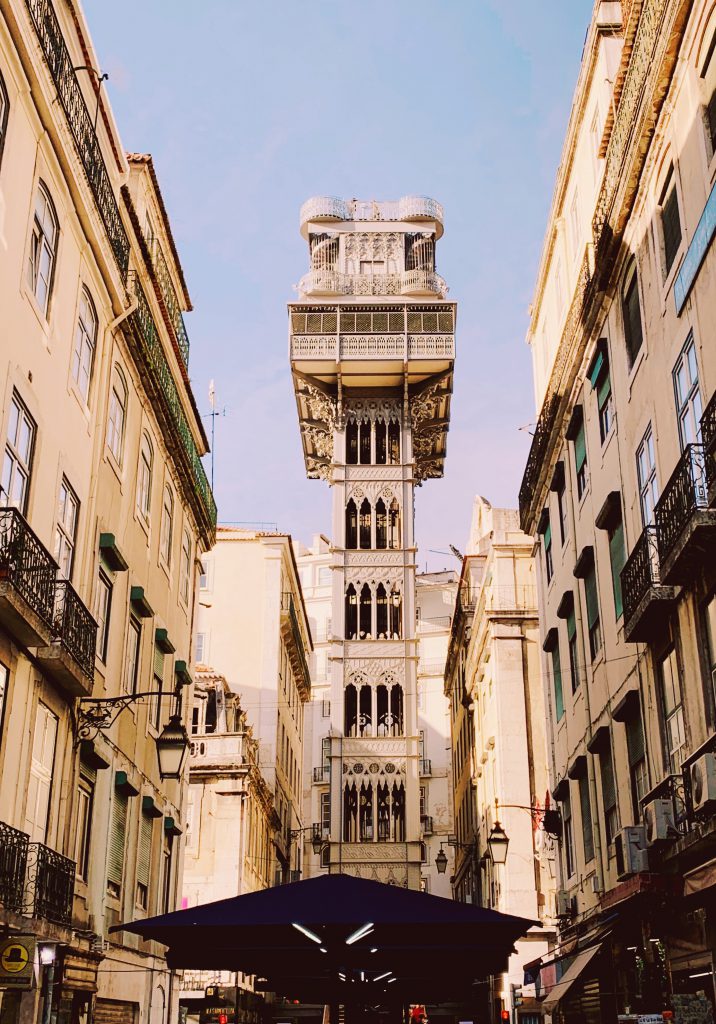
Elevador Santa Justa
One of the most unique and most recognizable structures in Lisbon is the Elevador Santa Justa lift. Built in the 19th century by Raoul Mesnier du Ponsard, a student of Gustave Eiffel (yes, the guy who designed the Eiffel Tower), the lift was designed to connect the lower level Baixa neighborhood to Carmo Square at the top.
The lift is a stunning example of Neo-Gothic architecture, decorated with intricate wrought-iron details and filigree motifs. It is the only vertical lift in the city and was steam powered until 1907.
The Elevador Santa Justa is still in operation, and while you can take it up to the viewing platform, this is something that you should skip. Not only will you wait an insanely long time in line, the elevator ride itself barely takes only 10 minutes!
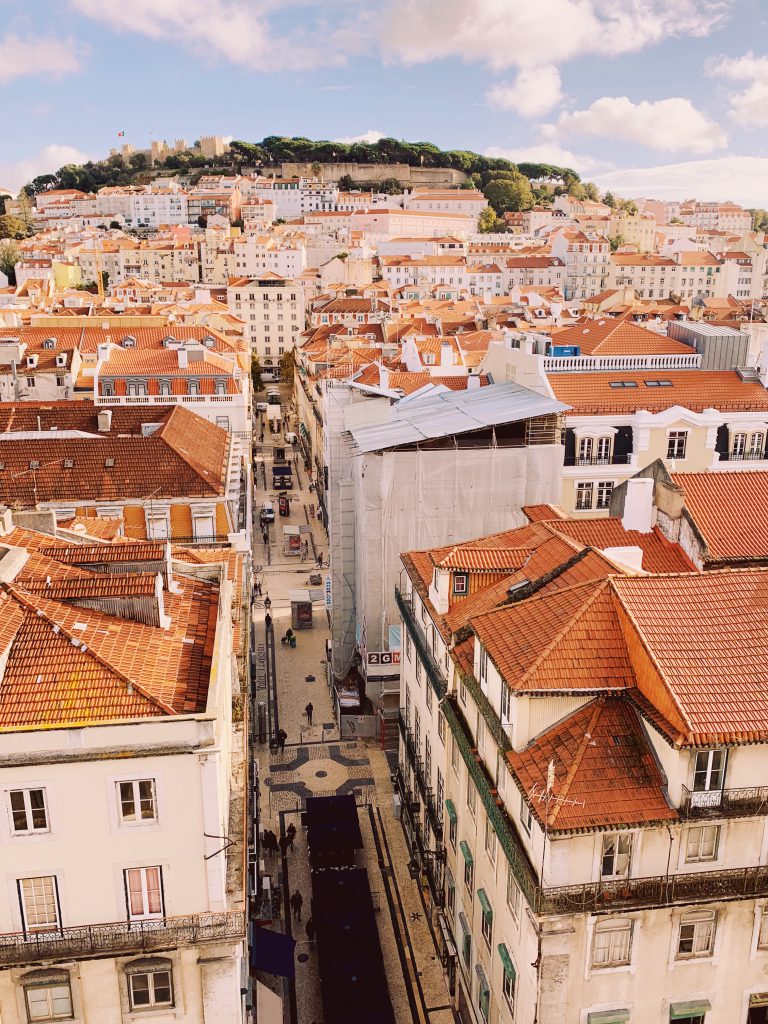

Instead, bypass all those suckers standing in line and head towards Rua do Carmo, right behind the Elevador Santa Justa. Here, there is a passageway (next to the church) that will lead you to the top. There is a normal elevator in a small shop in the building behind the backside of the elevator that you can take to the same viewing platform, for free – congratulations – you’ve now skipped one of the biggest tourist traps in Lisbon!
From the viewing platform, you can enjoy beautiful panoramic views of central Lisbon. You definitely do want to check out the view from here, as it is one of the best views in the city!
Hours: 7:30am-9pm (winter), 7:30am-11pm (summer)
Admission: €1.50 for viewing platform only, €5.30 for elevator + viewing platform
Carmo Convent (Igreja do Carmo)
At the top of the Elevador Santa Justa is the ruins of a former Catholic convent. The 14th century church and monastic complex was once the largest church in Lisbon until the great 1755 earthquake.
The devastating earthquake ruined most of Lisbon’s buildings beyond repair and turned much of the city into a pile of rubble. However, one of the structures that survived somewhat intact was the Carmo Convent. Reconstruction began a year later, but were stopped after religious orders in Portugal were abolished in 1834.
Today, you can see what remains. The roofless nave and the beautiful high arches are some of the most fascinating things you will see on your 3 days in Lisbon. There is also a small archaeological museum housed in the main body of the church, showcasing a collection of artifacts, tombs, and even mummies.
Hours: Monday-Saturday 10am-6pm (October-April), Monday-Saturday 10am-7pm (May-September). Closed Sunday
Admission: €5 for archaeological museum

Rua Augusta
After visiting the Santa Justa life and the Carmo Convent, start making your way towards Commerce Square (Placa do Comercio). Along the way, stroll down Rua Augusta, known as one of the main shopping streets in the city.
The street is always lively and vibrant, and you’ll find lots of terraces, street artists, and music. You’ll find a mix of both international and local stores here, and it’s a great spot to shop for some souvenirs.
At the end of the street, you’ll find the triumphant Arco da Rua Augusta arch. This grand arch, frames the entrance into Placa do Comercio.

Commerce Square (Placa do Comercio)
Placa do Comercio is Lisbon’s largest and most famous square. It borders the waterfront of the Tagus river and is surrounded by many restaurants, offices, bars, and shops. It once used to be home of the royal palace, but this was destroyed in the great earthquake.
The square was completely rebuilt after the original had been destroyed in the earthquake. Today, it plays host to many festivals and events in the city.
There are plenty of photo ops at Placa do Comercio, and it is one of the best places to photograph the monumental Arco da Rua Augusta. This arch was built as a symbol of rebirth after rebuilding after the 1755 earthquake. You can actually go up to the top of the arch – I hear it has some great views!
The centerpoint of the square is the giant statue of King Jose I on horseback, overlooking the river. The beautiful historic buildings framing the square, and the 18th century arcades are lovely to look at as well. It’s a great spot to walk around, check out the river views, and people watch. Careful though – pickpockets are common here, so keep a close watch on your belongings!
Hours: 9am-7pm, daily
Admission: €3, buy tickets here

Conserveira de Lisboa
Check out the iconic Conserveira de Lisboa. You may or may not know that sardines and canned fish are a big thing in Portugal. While you can find these tins of fish at various shops in the city, Conserveira de Lisboa is one of the original ones and has been around for over 80 years.
I was originally intrigued by the shop because I had seen a photo somewhere of its highly Instagrammable shelves, lined with colorful tins of fish, each with beautifully designed retro packaging.
There are many kinds of fish sold in these tins, including sardines, mackerel, tuna, octopus, and more. They range in price from €3-4 all the way up to some that are €30. The best part, they have a selection of samples! The service is also friendly and helpful as well.
It is such a fun shop to check out! They also make great souvenirs, and I took a bunch of tins home with me (they did light up the X-ray machine at the airport though, and I had to undergo secondary screening).
Hours: Monday-Saturday 9am-7pm, closed Sundays

Lisbon Cathedral (Se de Lisboa)
You will eventually make your way towards the Alfama district. While you can choose to take the famous Tram 28 there, I highly suggest walking there, as wandering through the streets of the city was one of my favorite things to do.
Not only that, the 28 tram is kind of a giant tourist trap, and always crowded AF. Pickpocketing has also become rampant on these trams. The influx of tourists on the 28 tram has also been problematic for the locals, who use them as a means of commuting. The overcrowding has become a major issue as locals are now finding it difficult to get to where they need to go.
Besides, I truly feel that walking the streets of a city really gives you a feel for the heart of it and is the best way to see and experience it!
While making your way towards Alfana, make a stop at the Lisbon Cathedral. You know how basically every city in Europe has that one church that is old and significant? This is Lisbon’s. The cathedral dates back to the 12th century and is the oldest church in the city, and has great architectural significance.
The church has survived a number of natural disasters (including the great earthquake of 1755), so it has been modified, rebuilt, and rebuilt a few times over the course of its history. Because of this, there is a mix of architectural styles represented, including Gothic, Neoclassical, Romanesque and Rococo.
The church’s imposing facade resembles a medieval fortress, with two large towers and an intricately carved rose window. Inside, you’ll find breathtaking stained glass windows. Also worth checking out is the cloister, where you will find recently excavated Roman, Arabic and Medieval remains. It also holds several notable tombs.
Hours: 7am-7pm
Admission: free for cathedral, €2.50 for cloister


Get Lost in the Streets of Alfama
Wandering through the streets of Alfama, Lisbon’s oldest districts, was by far my favorite thing that I did on my 3 days in Lisbon itinerary. I know “getting lost” sounds super cliche, but this is exactly what I ended up doing – I spent hours just wandering aimlessly through the labyrinth of the narrow, winding streets here.
Alfama was first occupied in the fourth century by the Romans and Visigoths, but it was when the Moors moved in during the eighth century that gave it its current atmosphere and name. The web-like maze of streets in the neighborhood was originally designed as a defense system and to help keep homes cool in the summer.
It is also the only area of the city that survived the great earthquake, due to its position on top of a sturdy bedrock. Many of the residents’ families have lived in the neighborhood for generations. Part of me wishes that I did a walking tour of the neighborhood, because the history behind it is so interesting, and I would’ve loved to hear more stories about it!




Even if wandering isn’t your thing, you need to spend at least a little bit of time exploring these streets. The area is filled with a maze of windy alleyways, narrow cobblestone streets, and steep stairways. You’ll find plenty of eye candy here, with pastel colored faces and azujuelos-tiled buildings (often with laundry hanging in front of it). Not only that, there are many epic viewpoints to be found in the neighborhood!
Be sure to have your camera at the ready, because there is definitely no shortage of photo ops in Alfama. I literally took hundreds of photos while wandering through the neighborhood because it was so photogenic!

Miradouro Sophia de Mello Breyner Andresen
This miradouro, which stands on top of a hill in Alfama, may just have been my favorite viewpoint . The viewpoint here is very expansive, and you can see those beautiful iconic red rooftops extending all the way out to the Tagus River. Off in the distance, you can catch a glimpse of the 25 de Abril Bridge, a sweet addition to the epic view.
Miradouro Santa Luzia
The Miradouro Santa Luzia sits just down the hill from the Miradouro Portas do Sol, which will be our next stop on this Lisbon 3 day itinerary. The view from here is pretty similar to the one from Portas do Sol.
However, what makes this miradouro unique, and worthy of a stop , is the beautiful garden here. With its gorgeous tilework, pretty flowers, and red doors, it is one of the most popular miradouros in Lisbon and apparently a popular spot for engagement photos (it’s easy to see why).


Sunset at Miradouro Portas do Sol
Yes, another miradouro – seriously, could not get enough of those epic views! I saved this one for last because here is a rooftop bar here, and it is the perfect spot to watch the sunset.
One of my favorite memories during my time in Lisbon was sitting here with a glass of chilled white wine in hand, being mesmerized as golden light danced upon the orange rooftops, and as the sky transformed into a cotton candy pink, then blue. I mean, seriously, what could be better than that?
Watch a Live Fado Performance
End day 2 by taking in a live fado performance. What is fado, you ask? It is a genre of traditional music that originated in the city in the 18th century. It is kind of like the Portuguese version of the Blues, very melancholy, and full of longing and emotion.
The Portuguese concept of saudade, is often used to describe fado. It refers to a longing both for what has been lost and for what has never been attained.
You will find no shortage of fado bars lining the streets of Bairro Alto and Alfama. Many of them are also restaurants, so you can eat dinner while listening to some fado music if you choose.
I ended up going to Tasca do Chico in Bairro Alto, which came highly recommended by several sources. It was where Anthony Bourdain went on the Lisbon episode of his show, and anywhere that’s good for Tony is good for me!
You will probably find a line of people waiting to get in, but since the bar puts on 2-3 song sets every 30 minutes, the crowd turns over pretty quickly. Even still, once you get in, you’ll probably find that the bar is pretty packed so chances are it will be standing room only. Still, I enjoyed listening to the fado here – it was definitely unique and a very moving experience, for sure
If you want to sit down for an actual fado concert rather than listen to it at a bar, this performance comes highly rated.



Other Things to Do on Day 2 of Your 3 Days in Lisbon Itinerary
I spent a lot of time getting lost in the streets of Alfama on day 2 of my 3 days in Lisbon itinerary, so that ended up taking up a good portion of my day. If wandering is not your thing, or you find yourself with extra time, I suggest the following activities to fill up the rest of your day:
- Sao Jorge Castle (Castelo Sao Jorge): I did originally have this on my itinerary, but ended up getting lost on the way there and did not feel like backtracking up the very steep hill. The Sao Jorge Castle dates back to the 8th century, and is one of the most notable attractions in Lisbon – you can even see it from almost anywhere in the city! There are also epic views from here as well. You may consider booking this skip-the-line ticket, which also comes with a 15-minute tour. (Hours: 9am-9pm (summer), 9am-6pm (winter); Admission: €8.50)
- Fado Museum: If you want to get more of an insight into this iconic Portuguese music style, and learn more about the history and its origins, consider stopping by the Fado Museum. This will also give you an idea of what to expect for your first fado performance. (Hours: Tuesday-Sunday 10am-5:30pm, closed Mondays; Admission €5)
- Azulejos Museum: One of my favorite things about Lisbon (and about my time in Portugal in general) was seeing the iconic Azulejos tiles everywhere I looked. It’s a little bit out from the central part of Lisbon, but easily doable as an addition after spending time in Alfama. The museum has exhibits about the history of the tiles and Portuguese oil painting, but also has an impressive 1300 tile panel depicting the city before the 1755 earthquake. (Hours: Tuesday-Sunday 10am-6pm, closed Mondays; Admission: €5)
3 Days in Lisbon Itinerary: Day 3 (Fairytale Day Trip to Sintra)
For your last day, a day trip to the fairytale town of Sintra is a must! Sintra sits about 30 kilometers (18.5 miles) outside of Lisbon and once was used as a sanctuary for royals because of its mountainscapes and thick, dewy forests.
There is soooo much to see and do in Sintra that’s impossible to see it all in one day. Someone told me that realistically, you can visit 2-3 monuments in one day; since I travel fast, I thought I would definitely get in at least four, but ended up only covering three.


How to Get to and Around Sintra
Sintra is easily accessible from Lisbon via train, which departs Rossio station every 30 minutes. The trip takes about 45 minutes, and costs €2.30. If you are planning to use public transportation in Lisbon later in the day, you can also get a CP/Metro/Carris day pass for €10.70.
You can also explore Sintra via a guided tour – part of me wishes I booked this because it also makes stops in Cascais and Cabo do Roca (the westernmost point in Europe), both of which I really would’ve loved to see!
Once you arrive in Sintra, there are two sightseeing bus routes that will get you to the palaces and monuments. The bus 434 stops at the historic center of Sintra and the National Palace of Sintra (Palacio Nacional de Sintra), Castle of the Moors (Castelo dos Mouros), Pena Palace (Palacio Nacional da Pena), and goes back to the Sintra station. You can purchase a single-ride ticket for €4.10 or a hop-on, hop-off ticket for €7.60, which will allow you to make the entire loop in one direction, no backtracking.
Bus route 435 stops at the National Palace of Sintra (Palacio Nacional de Sintra), Quinta da Regaleira, Setais Palace (Palacio de Setais), and Montserrate Palace (Palacio de Monserrate). The 435 bus costs €5 and works similarly to the 434 line. You can also buy a day pass that serves both lines for €15, which is also valid for the bus going to Cascais.
Another option is to book on this hop-on, hop-off bus tour which; again, in hindsight, I wish I did this because it also makes stops at Cascais and Cabo do Roca.
This was my Sintra day trip itinerary:


Pena Palace (Palacio Nacional de Pena)
When you think of Sintra, chances are that you think of the colorful Pena Palace. It is by far the most popular of all the attractions in Sintra, so expect a crowd – I showed up at 10:30 am (30 minutes after opening) and it was already swarming with people! Definitely buy tickets in advance to save time.
That said, Pena is popular for a reason – I mean, the brightly colored facades and Romance-style towers look straight out of a Disney movie! The palace was built by King Ferdinand II, who had an artistic eye and a taste of the extravagant, which resulted in this masterpiece.
What many people don’t realize is that Pena refers to both the palace and the surrounding park. The actual palace is about 1.5 kilometers away from where the 434 bus drops you off. You can either walk, or take another shuttle to get to the palace.


There are two ticket options: one for the park only, which also allows you to see the outside of the castle; and a combined park and palace ticket, which will allow you to see the inside of the palace. To be honest, I found the inside to be a bit underwhelming, so in hindsight, I would’ve just skipped it and spent that time adding another palace to my itinerary.
Hours: 10am-6pm (winter), daily; 9:30am-7pm, daily (summer)
Admission: €14 for park and palace; €7.50 for park only (buy skip-the-line tickets here)


Sintra Historic Center
Since I intended for my next stop to be Quinta da Regaleira, I needed to get back to the historic center to catch the 435 bus (you can also walk there once you get back to the historic center). Lots of cute shops, churches, restaurants, and cafes line the charming streets and narrow stairways here – be sure to set aside at least a little bit of time to wander through them!
It is also a great opportunity to stop for some lunch and refuel for the rest of your day! I unfortunately ended up losing track of time while I was exploring Pena Palace and ended up getting really hangry and ate at the cafeteria there out of desperation. The food there was overpriced and not great at all, so I wish I had just eaten at one of the many restaurants in the historical center instead.

National Palace of Sintra (Palacio Nacional de Sintra
Since the National Palace of Sintra is right in the middle of the historic center, it is an easy and worthwhile stop on your Sintra day trip. The beautifully preserved medieval palace dates back to the 8th century and was the most lived-in royal palace in Portugal.
The almost all-white Gothic-style exterior, with two massive chimneys, is a picture-perfect sight. You can also get some beautiful views of the town and its hills from the courtyard here. The inside of the palace is lavishly decorated, with extravagant golden details throughout.
Hours: 9:30am-6pm, daily (winter); 9:30am-7pm, daily (summer)
Admission: €10 (buy tickets here)


Quinta da Regaleira
The sprawling Quinta da Reglareira was originally built for the Viscondessa da Regaleira in the last days of the Portuguese monarchy but was later acquired by and used as an estate for an eccentric millionaire.
Quinta da Regaleira spans over 4 hectares (almost 10 acres), and is full of lush trees, vegetation, ferns, and hidden pathways. As it is on the outskirts of town, it attracts far few people than Pena Palace, and feels like a respite from the madness.
The main draw here is the Initiation Well, built seven stories into the ground and connecting to a network of hidden passageways that span the entire estate. You can climb down the well and walk through the dark tunnels, exiting back to the main garden through a passage of stepping stones that lead through a waterfall – a super cool experience!
Hours: 9:30am-6pm (winter), 9:30am-8pm (summer), daily
Admission: €6 (buy tickets here)

Other Things to See at Sintra
If you have extra time during your day trip to Sintra, or you are feeling extra ambitions, I would recommend stopping also adding the following sights to your itinerary:
- Monserrate Palace (Palacio de Monserrate): I had intended to stop at Montserrat after Quinta da Regaleira, but since the estate is huge and has a bunch of uphill walking, I ended up tiring myself out. In hindsight, I would’ve skipped seeing the inside of Pena Palace to save time and energy for Monserrate – but hey, hindsight is 20/20, eh? Monserrate sits at the very far end of Sintra, so it sees far fewer crowds and has even more of a hidden vibe. Not only that, it has stunning tile details and arches, along with lush, beautiful gardens. (Hours: 9:30am-8pm, daily (summer), 10am-6pm, daily (winter); Admission: €8; buy tickets here)
- Castle of the Moors (Castelo dos Mouros): This is one of Sintra’s most popular attractions and a convenient option since it is along the 434 bus line. The 9th century ruinous castle is situated on top of a hill and was originally used as a military fort, due to its unique vantage point of the Tagus River. Not only does it have an amazing history seeping from behind its high fortified walls, it provides unparalleled views of the village and beyond. (Hours: 9:30am-8pm, daily (summer), 10am-6pm, daily (winter); Admission: €8; buy tickets here)
Read more: Planning a Fairytale Lisbon to Sintra Day Trip
Where to Eat in Lisbon
Lisbon is starting to gain a reputation as a world-class foodie destination, and I definitely enjoyed eating may around the city!
One thing to keep in mind when dining in Lisbon (and Portugal in general) – oftentimes when eating at a restaurant, they will bring out some starters, usually bread, olives, cheese and/or olive oil. These are not complimentary! The restaurant will usually tack on a nominal charge, usually around €2-5 for these. If you want them, go ahead and have them, otherwise, tell the staff that you don’t want them and they will take them back.
Okay now that we got that out of the way, onto the food!


Taberna da Rua das Flores
Taberna da Rua das Flores came highly recommended to me by several people, so it was at the top of my list of places to eat during my 3 days in Lisbon. It definitely did not disappoint!
It serves traditional Portugueuse food with a modern twist, featuring unique flavor combinations that you wouldn’t think work – but it completely does! The menu, which is written on a chalkboard that is displayed in the restaurant, changes every day and features seasonal local ingredients.
The dishes are served in small plates, so it is better if you come as a group so you can share everything. I was a solo traveler, so I was only able to try two things and I really wished I was able to eat more! Both dishes I had were fantastic – the first was a squid carbonara (squid sliced to look like pasta and then covered in carbonara sauce), and the second an excellent shrimp dish.
It is a tiny restaurant, and very, VERY popular – either make reservations or get there super early! I tried to eat here on my first night in Lisbon and got there around 7pm, and was turned away because they were already booked for the night. I returned the second night around 6pm, and they squeezed me into a tiny little corner spot that wasn’t even a table!
They don’t accept credit cards, so bring some cash.
Hours: Monday-Saturday 12-4pm, 5pm-11:30pm; closed Sundays


Bairro do Avillez
Bairro do Avillez is a concept from Jose Avillez, one of Portugal’s famed chefs. He has several restaurants in the city, but Bairro do Avilez was interesting to me because it had four different restaurants under one roof.
There is something for everyone, depending on your taste and budget: Mercaria, a gourmet deli for those wanting to grab something quick on-the-go; Taberna, which has hearty traditional food in a casual setting; Pateo, which focuses on fish and seafood dishes; and the more upscale Beco, at which you can enjoy your dinner with a cabernet show.
I ended up dining at Taberna, because I was in the mood for something more traditional. But traditional doesn’t mean boring – they put a twist on every single dish here. The dishes here are also served tapas style, and I definitely wish I was able to try more!
My favorite here was the Bacalhau, or salted cod, which is known as the national dish of Portugal – you must have Bacalhau at least once! It is said that there are a thousand ways to prepare it – Taberna’s version is served with cornbread, chorizo crumbs, and onion puree (which totally elevated the dish).
Taberna and Mercaria hours: noon to midnight, daily
Pateo hours: 12:30pm to 3pm; 7pm to midnight, daily
Beco hours: see here


1300 Taberna
I made a stop here while I was checking out the LX Factory on day 1 of this 3 days in Lisbon itinerary, and really ended up enjoying my meal! 1300 Taberna dishes out creative, fun spins on traditional Portuguese favorites.
Not only that, the atmosphere here is super cool – it’s a converted industrial space that is decorated in a super funky, eclectic style.
I had heard that the catch of the day was a good place to start, so that’s what I ordered. It came on a bed of tomato rice – it was super comforting and delicious! If you have an appetite or want to taste the best of what they have to offer, they also have a fairly affordable tasting menu.
Hours: Tuesday-Saturday 12:30pm-3:30pm/7:30pm-midnight; Sunday 12:30-3:30pm
A Cevicheria
Ok so admittedly, I didn’t get a chance to make it out to the actual restaurant and only ate at A Cevicheria’s outpost inside the Time Out Market. It still ended up being one of my favorite things that I ate, so of course I had to mention it on this list!
A Cevicheria is the brainchild of Chef Kiko, one of the most popular chefs in Lisbon. Here, he combines Peruvian favorites, i.e. ceviche, with a local Portuguese flavors. Some of their dishes have an Asian flair as well.
The actual restaurant is supposed to be tiny and it’s one of the most popular places to eat in Lisbon. There are no reservations, so get there early!
Hours: 12pm-midnight, daily


Mantegaria
While everyone flocks to Pasteis de Belem for pasteis de nata, Belem is a bit of a trek. Mantegaria is right in the middle of central Lisbon, and is just as good – it was tied for my favorite pasteis de nata in town! To me, Pasteis de Belem had a slightly better crust, but I preferred the custard at Mantegaria.
I ended up stopping AT LEAST twice a day during my 3 days in Lisbon (don’t judge me…but seriously, they were THAT good). Since they are located right in the middle of the city, it’s easy to stop for a quick pastel de nata or two on the way to other stops on this itinerary!
Hours: 8am-midnight, daily


Landeau
I mentioned Landeau earlier as a stop at LX Factory on day 1. I basically spent the rest of my time in Lisbon craving that deliciously rich chocolate cake.
What I didn’t realize is that they also have a second in Chiado, so I could have easily made another stop, without having to trek back to LX Factory.
I can’t say enough about how good the chocolate cake was here – it’s sooooo rich and the chocolate they use is perfection. Seriously still have dreams about the cake here!
Hours:
LX Factory : Sunday-Thursday 11am-8pm; Friday-Saturday 11am-11pm
Chiado: 12pm-7pm, daily
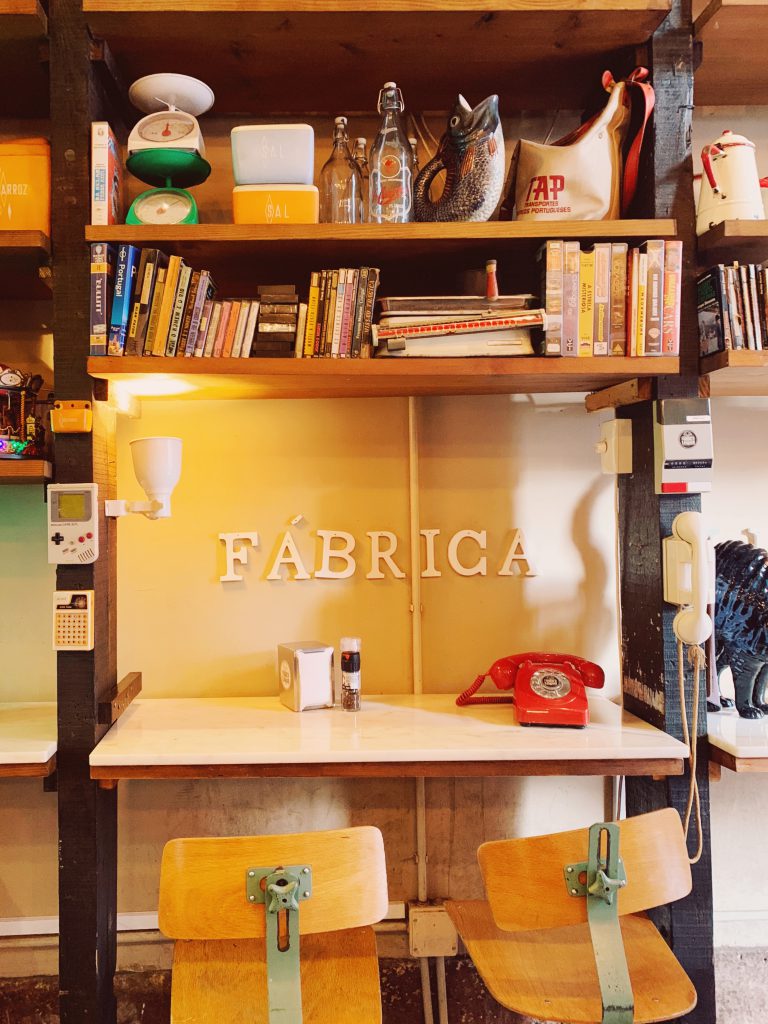
Fabrica
This is a great spot for coffee and a quick breakfast. They have a few locations throughout the city, but the one on Rua da Madalena, right next to Alfama, is the cutest little spot. The coffee and toast are on point here!
Hours: 8am-7pm, daily
Cervejaria Ramiro
Full disclosure, I didn’t actually dine at Cervejaria Ramiro…but pretty much EVERYTHING I read about Lisbon mentioned that it was a must. It also became famous after it was featured by Anthony Bourdain. If you love seafood, it’s your spot! There is always a looooong wait, so I had to skip it. Would love to come back to dine here sometime, though!
Hours: Tuesday-Sunday noon-12:30am, closed Mondays
Have you ever been to Lisbon? What are your picks for what to do, see, and eat in 3 days in Lisbon?
You might also like:
One Day in Sintra Itinerary
3 Days in Barcelona
2 Days in Florence
2 Days in Paris






Caroline is a Southern California based traveler, writer, and photographer. She travels all around California, the US, and the world in search of the most colorful places, the most delicious food, and bucket-list adventures. Her aim is to inspire other travelers discover how to add more adventure and joy to their lives. On Pictures & Words, you’ll find detailed guides + itineraries, along with vibrant photos to help you plan the the most epic trips. When she’s not traveling, Caroline also runs half marathons.

Franny
Thursday 20th of August 2020
I have only been to Lisbon once! However this here is convincing me I need to go back.
Olivia
Monday 17th of August 2020
Beautiful blog and photos! I was supposed to visit Lisbon this August but unfortunately my trip was postponed. I'll definitely be saving this post for when I finally get to visit!
Nina
Tuesday 21st of January 2020
This is a view helpful blog with so much information! I am going to Lisbon in less than 90 and this has all of the pertinent information in one location. Thank you so much!!!
Co | Travel with Co
Sunday 19th of January 2020
What perfect timing to stumble upon this post! I'm heading to Lisbon in a couple of weeks, so I really needed this. Thanks for sharing!
Maria Elsa Jose
Sunday 19th of January 2020
Great architectural design. You had amazing photos! Such cute smiles!